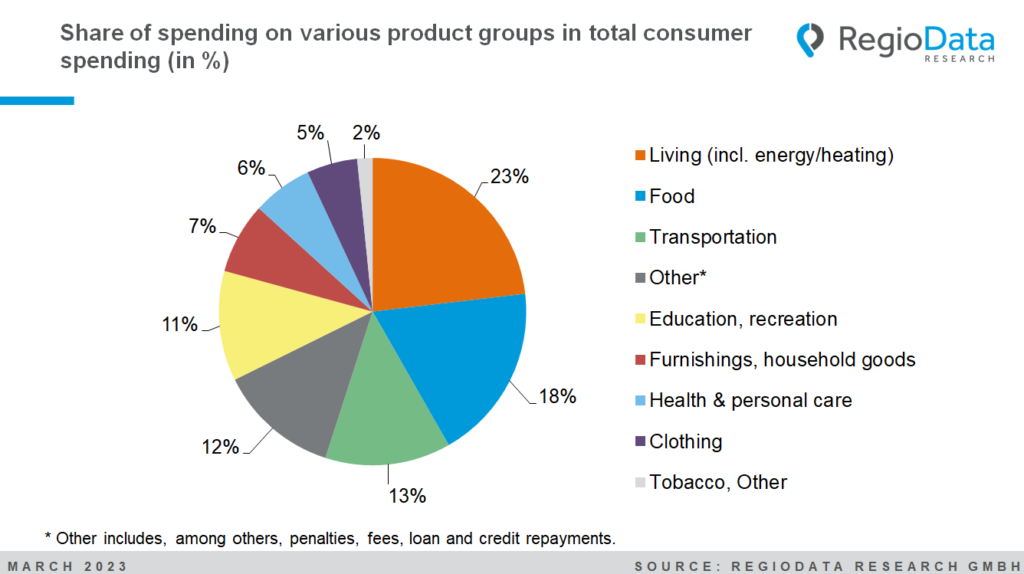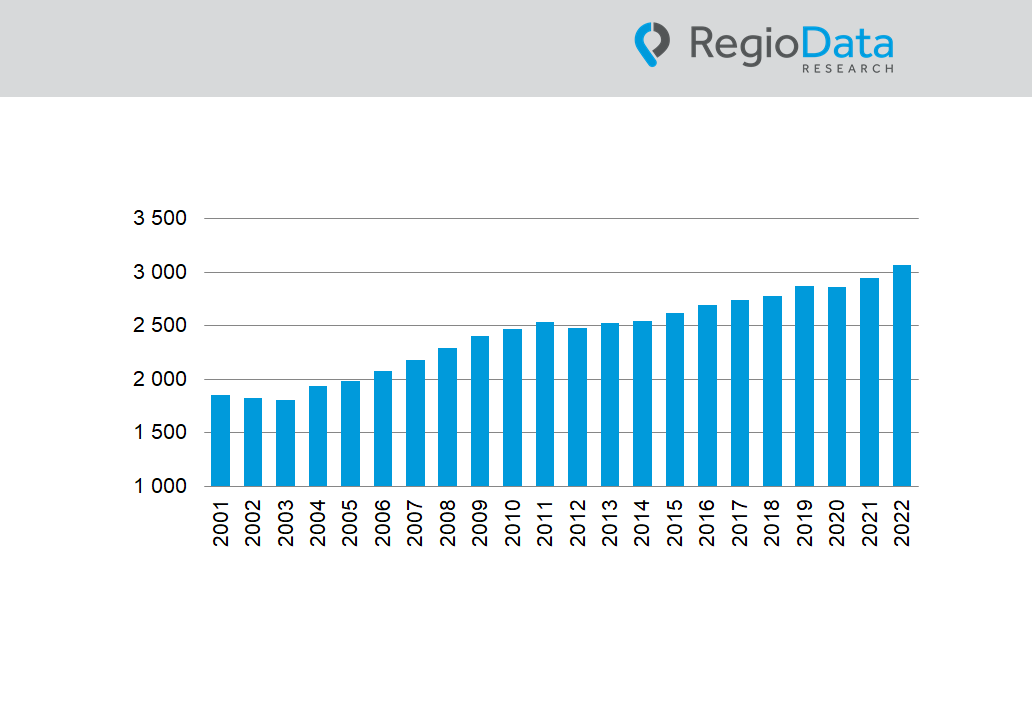Austria
Consumption shift - Corona has changed habits forever
In 2022, an average Austrian had around €25,100 at their disposal. This represents a 15.4% increase in the population’s expenses over the past five years. However, the Corona pandemic has had a strong impact on recent spending habits. RegioData Consumer Spending shows that this has not only shifted people’s priorities, but has also fueled certain areas of spending and brought others to a halt.
Private expenditure of € 22,000 per capita per year
With consumer expenditures of € 25,100, an individual in Austria spends an average of approximately €22,000 per year on personal consumption purposes. This represents an 8.5% increase in total expenses compared to the previous year, but only in nominal terms. Currently, non-private consumption expenditures such as fines, loan repayments, savings deposits, and other funds account for approximately 12.4% of the total expenses.
(Consumer expenditures include all expenses made by an individual within a year for purchases or services in a specific category, regardless of the source of procurement (domestic or foreign). The figures include the statutory value-added tax.)
Food and housing are the largest expenditure categories
The average Austrian spends around € 4,600 a year on food. This accounts for 18.2% of total consumer spending. The proportion allocated to food has already increased by 17% compared to the previous year. Looking back 10 years, in 2012, approximately €3,200 was spent on food.
While expenses for meat and fish have only slightly increased, there has been a 10% increase this year in expenditures on dairy products and eggs. Expenditures on dairy substitutes alone have seen a remarkable 500% increase since 2019. There seems to be a significant surge in non-alcoholic beverages (+11%), particularly still mineral water. The trend of water carbonators (SodaStream, Soda Trend) has propelled spending on mineral water to €40 in 2022, representing an 18% increase compared to the previous year.
The expenditure on housing closely follows at €4,400, with this share also increasing by 6.6% this year. When including heating and energy costs, the share of housing expenses accounts for 23% of the total consumer expenditures. Transportation costs, both for private and public transport, amount to approximately €3,300 and are also significant expenses.
Out-of-home consumption is steadily increasing
The increases in the food sector are primarily driven by higher expenditures on out-of-home consumption (+51%). Approximately €1,600 is spent on eating out per year. This represents about 36% of the total consumer expenditures on food, compared to 27% in the previous year, possibly due to the impact of the pandemic. Out of this, around €1,300 is spent solely on dining out at restaurants, cafes, pastry shops, and other external delivery services during leisure time.
Delivery services have gained popularity in recent times. Since 2017, expenses for “meals on wheels” have nearly doubled and currently amount to €86 per person per year.
Corona trends have a long-lasting effect
The impact of the COVID-19 pandemic has profoundly shaped the landscape of trends and led to a realignment of consumption and behaviors. One significant trend is the increasing demand for dietary supplements, which has grown by 27%. On average, Austrian residents spend around €40 per year on dietary supplements, which is roughly equivalent to what they spend on spirits or ready-made meals.
While tobacco consumption in Austria had been declining in recent years, the pandemic has triggered a significant boom in tobacco products. Not only have total expenditures on tobacco increased (+8%), but new “vape pens” have also rapidly spread. An average of €30 was spent on the colorful and fruity disposable electronic cigarettes in 2022 – about as much as on apples.
The balance before and after the pandemic also shows increased activities in baking (+26%) and cleaning (+40%). There has also been a significant rise in streaming demand (+44%). An Austrian spends approximately €70 per year on private TV, radio, including streaming services, which is equivalent to the annual supply of pork.
New hobbies include a surge in e-bikes (+136%) and hunting sports (+47%). Conversely, a downward trend can be observed for alcoholic beverages, landline telephones, as well as travel guides and pictorial books.
The reawakened relevance of one’s beauty care
In 2022, Austrians spent an average of around 13% more on personal hygiene than in the previous year. After a relapse in the pandemic period, hygiene is thus becoming increasingly relevant again, but is still below the pre-crisis level, with total annual spending of € 565.
Per year, each Austrian spent around € 35 on perfumes and deodorants, equal to the amount spent on butter. There was also a comeback for chic hairstyles. Spending on women’s hairdressing increased this year from around €140 to €180. For men’s and children’s hairstyles, about €40 was spent in 2022 (+30%).
Despite or perhaps even because of the COVID-19 pandemic, there has been a significant boom in the demand for cosmetic surgeries, including non-surgical procedures. More than € 40 per inhabitant and year was spent on this, representing an increase of 18 % over the previous year.
Retail-related consumer spending on a slightly declining trend
At currently € 1,300 per year, clothing expenditure has slightly caught up with the pre-crisis level. A woman spends around €500 a year on clothing – 77% more than men. The average annual expenditure on women’s shoes alone (around €115) corresponds to the value of shoes, underwear, shirts and other utensils in the men’s segment.
Although spending on classic consumer products such as clothing, shoes, electronics, household goods, furniture, etc. (totaling € 7,900) has risen somewhat recently, the retail-relevant share of consumer spending is heading in a downward direction. While the share of clothing was 6% three years ago, this year it is 5%. The retail sector currently accounts for only about 30% of private consumer spending.
Share news



